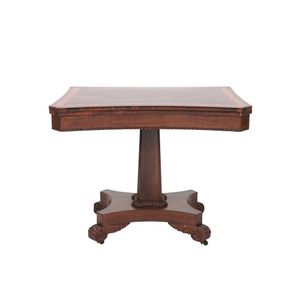A George IV satinwood-banded rosewood games table, early 1820s,…
A George IV satinwood-banded rosewood games table, early 1820s, the fold-over top with concave front and sides and cross-banded with satinwood enclosing a green baize lined playing surface, raised on a square spreading pedestal with a gadrooned foot on the platform base with scrolling foliate feet and casters, the pedestal and platform base both concave-sided, conforming with the top, 72 cm high, 94 cm wide, 51 cm deep (not extended)
You must be a subscriber, and be logged in to view price and dealer details.
Subscribe Now to view actual auction price for this item
When you subscribe, you have the option of setting the currency in which to display prices to $Au, $US, $NZ or Stg.
This item has been sold, and the description, image and price are for reference purposes only.
- Satinwood - Satinwood is a dense pale gold coloured timber that was imported into Britain in the second half of the 18th century, and early 19th centuries from the East Indies and the West Indies. The name derives from the satin-like surface sheen when the timber is polished.
It was used in the solid, as a veneer and in inlays. As well as furniture, satinwood was used for making musical instruments, barometers, boxes and clocks.
It will usually be found on only the very best quality objects, presumably because of of its cost at the time. - Foldover - A term used when describing card, tea or games tables, where the top folds over onto itself when not in use. The interior surfaces that are exposed when the top is open may be polished (in the case of tea tables) or baized (for card or games tables).
- Gadrooning - A series of lobes usually as a border. In furniture gadrooning is found as carved decoration around the edges of table tops in the Chippendale and Jacobean style furniture. Gadrooning is also found as decoration on the rims of silver and ceramics.
- Rosewood - A dense timber that varies in shade to very light brown to almost black. When rosewood is cut and sanded the colour of the timber will turn black, and after polishing and exposure to daylight, the surface will gradually lighten over time to light brown with black streaks.
The name comes from the odour emanating from the timber when it is planed, sanded or cut.
Rosewood was very popular for use in Victorian furniture in the second half of the 19th century, and at that time most of the rosewood was imported from Brazil. However it also grows in India and Indonesia.
It is used in the sold for chairs and table legs, but for carcase furniture such as side cabinets and bookcases, and for table tops it is always used as a veneer. - Crossbanding - Crossbanding is a decorative technique used in furniture-making, where thin strips of wood, known as crossbands, are applied to the surface of a piece of furniture to create a decorative border or inlay. The crossbands are typically made of a different type of wood or a different color than the main piece of furniture, and are applied in a geometric pattern, such as a checkerboard or herringbone design.
Crossbanding was a popular decorative technique in furniture-making from the 17th to the 19th centuries, particularly in the Baroque, Rococo, and Chippendale styles. It was often used to create intricate patterns and designs on the surfaces of tables, desks, cabinets, and other pieces of furniture. The crossbands were often made of exotic woods, such as ebony or rosewood, which were imported from other parts of the world and were highly prized for their rich colors and patterns. - Foliate - Decorated with leaves or leaf-like forms.
- George Iv - George IV (1762 ? 1830) was king of the United Kingdom of Great Britain and Ireland and king of Hanover from 1820, until his own death in 1830. From 1811 until his accession in 1820, he served as Prince Regent during his father's final mental illness.
In English furniture design, his reign from 1811 to 1830 is known as the Regency period. - Baize - Baize is a type of fabric that is made from wool or a wool blend. It is a dense, closely-woven fabric that is smooth to the touch and has a matte finish. Baize is often used for covering surfaces, such as table tops or the playing surface of card, pool and billiard tables, and for lining drawers and boxes, because it is durable and resistant to wear. This fabric is often associated with gambling and is often used on casino gaming tables and other gaming equipment.
- Platform Base - Flat-surfaced bases supporting the pedestals of dining tables and some other smaller occasional tables, including console and pier tables. Introduced during the Regency period, they continued in popularity throughout the 19th century. On tables, platform bases are usually of triform, or three-cornered shape, supported by bun, turned or carved claw feet. They may be either of veneered box-like construction, or formed from the solid timber.
This item has been included into following indexes:
